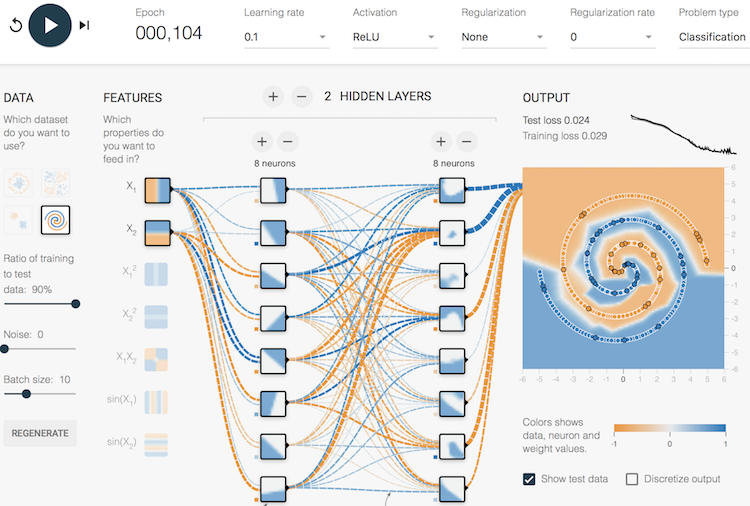Neural Network Tutorials - Herong's Tutorial Examples - v1.22, by Herong Yang
What Is Deep Playground
This section provides a quick introduction of Deep Playground, which is an open source interactive tool for learning classical neural networks.
What Is Deep Playground? Deep Playground is an open source interactive tool for learning classical neural networks. It was created by Daniel Smilkov and Shan Carter and is available on GitHub at https://github.com/tensorflow/playground.
A Web based version of Deep Playground is also available at https://playground.tensorflow.org. You can play with it with any Web browser without installing anything on your computer.
The picture below shows you a screenshot of Deep Playground.

Explanations of some interactive controls are given below:
Play control group - It provides 3 functions: Resets the model with weight matrices randomly initialized again; Stops/resumes the epoch loop; And runs 1 epoch only.
DATA - Allows you to select a specific pattern to generate the input dataset, which is a collections of (x1, x2, y). x1 and x2 is the input vector with values in the range of -6 and 6. y is the output has a value -1 (displayed in orange) or 1 (displayed blue).
REGENERATE - Regenerates the input dataset of the same pattern.
FEATURES - Allows you to reduce or expand the input vector. Additional input components like x1*x2 will improve the accuracy of the model.
HIDDEN LAYERS - Allows you to add or remove hidden neural network layers. It also allows you to control the number of nodes in each hidden layer.
OUTPUT - Shows the accuracy of the model for the training subset and the test subset. It also shows the prediction of any other input using the background color.
Table of Contents
►Deep Playground for Classical Neural Networks
Impact of Extra Input Features
Impact of Additional Hidden Layers and Neurons
Impact of Neural Network Configuration
Impact of Activation Functions
Building Neural Networks with Python
Simple Example of Neural Networks
TensorFlow - Machine Learning Platform
PyTorch - Machine Learning Platform
CNN (Convolutional Neural Network)
RNN (Recurrent Neural Network)
GAN (Generative Adversarial Network)